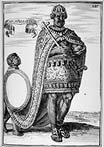Prestor John
Slowly, a reconceptualization of Africa and what the continent had to offer in terms of beneficial resources began to appear. The changes in the image of Prestor John help to demonstrate this point. Beginning in the 12th century, the person or legend of Prestor John was one full of intrigue, kingdom, courage and wealth. Prestor John was a priest-king, many believed of Far East or Ethiopian ancestry who belonged to the race of the three Magi, their former kingdoms being subject to him. Prestor John was said to have fought off the Persians attacking his home and was on his way to help defend the Holy Land but was rendered immobile by the Tigris river. It was his reported defeat of the Muslims that caused the Portuguese and Spaniards to search for him in the hopes of obtaining his aid in fighting the Moors on the Iberian Peninsula.
What is of interest to us is the change in the desirability to find this great legend as time passed and many more Africans began to arrive on the shores of Iberia. Colin Palmer (1998) suggests that “[B]y the time Columbus crossed the Atlantic, […], African slavery had become commonplace on the Iberian peninsula and the image of Africa had been shorn of any positive characteristics.” Ronald Sanders contends that the image of Prestor John became vulnerable during a time in which many African captives began to disembark from the very ships that were sent to search for him in the hopes of dismissing the Moors. Instead of finding the man who would dispel the Moors, it appeared as if the ships returned with increased numbers of “Moors” and “barbaros” to inhabit the peninsula.
This gradual change in the image of Prestor John accompanied the official introduction of the slave trade into Portugal beginning in 1440 by Prince Henry, The Navigator. Lisbon would be the destination of the first large group of African captives to the region. Their arrival was described by Gomes Eares de Zurara, the chronicler, as
“…a marvelous sight; for among them were some white enough, fair to look upon and well proportioned; others were less white like mulattoes; others again were as black as Ethiops and so ugly, both in features and in body, as almost to appear (to those who saw them) the images of a lower hemisphere…some kept their heads low and their faces bathed in tears.”
Here we begin to see a change in the perceived status of darker skinned Africans who were brought to the peninsula after 1440. The moral and intellectual climate of the time contributed to this change by associating “black” with misfortune and sadness and interpreting “black” as the color of the souls in hell. There were also beliefs that associated black skin with the curse of Ham.






